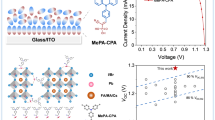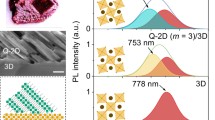Abstract
Bulk heterojunction (BHJ) organic photovoltaic (OPV) devices are generally composed of a blend film of a π-conjugated polymeric electron donor and a C60 derivative electron acceptor intercalated between an anode and a cathode, typical of a two-dimensional device structure. Often, a regioregular poly(3-hexylthiophene) (rr-P3HT) and indene-C60 bisadduct (ICBA) blend film is used as the BHJ active layer instead of the conventional P3HT and phenyl-C61-butyric acid methyl ester (PCBM) blend film due to the ICBA device’s higher power conversion efficiency (PCE), which is correlated with its higher open-circuit voltage (V OC ). To determine the quantitative influences of those electron acceptors in the BHJ OPV devices, we prepared various devices of acceptors, either PCBM or ICBA, with a wide range of blending ratios (from 0 to 100%) for estimating their typical optoelectronic properties, e.g., UV-visible absorption spectra, photoluminescence intensity, surface morphology, and photovoltaic device parameters. Obtained data were compared to each other and were analyzed as a function of their acceptor blending ratio.
Similar content being viewed by others
References
M. Jørgensen et al., Sol. Energy Mater. Sol. Cells 119, 84 (2013).
N. Espinosa et al., J. Mater. Chem. A 1, 7037 (2013).
P. W. M. Blom, V. D. Mihailetchi, L. J. A. Koster and D. E. Markov, Adv. Mater. 19, 1551 (2007).
G. Yu, J. Gao, J. C. Hummelen, F. Wudl and A. J. Heeger, Science 270, 1789 (1995).
J. D. Servaites, S. Yeganeh, T. J. Marks and M. A. Ratner, Adv. Funct. Mater. 20, 97 (2010).
M. D. Irwin, D. B. Buchholz, A. W. Hains, R. P. H. Chang and T. J. Marks, Proceed. Natl. Acad. Sci. 105, 2783 (2008).
T. J. Savenije, J. E. Kroeze, M. M. Wienk, J. M. Kroon and J. M. Warman, Phys. Rev. B 69, 155205 (2004).
J. K. J. van Duren, X. Yang, J. Loos, C. W. T. Bulle- Lieuwma, A. B. Sieval, J. C. Hummelen and R. A. J. Janssen, Adv. Funct. Mater. 14, 425 (2004).
X. Yang, and A. Uddin, Renew. Sust. Energ. Rev. 30, 324 (2014).
J. K. Lee, W. L. Ma, C. J. Brabec, J. Yuen, J. S. Moon, J. Y. Kim, K. Lee, G. C. Bazan and A. J. Heeger, J. Am. Chem. Soc. 130, 3619 (2008).
Y. He, H. Y. Chen, J. Hou and Y. Li, J. Am. Chem. Soc. 132, 1377 (2010).
G. Zhao, Y. He and Y. Li, Adv. Mater. 22, 4355 (2010).
P. K. Watkins, A. B. Walker, and G. L. B. Verschoor, Nano Lett. 5, 1814 (2005).
WH. Baek, TS. Yoon, H. H. Lee and YS. Kim, Org. Electron. 11, 933 (2010).
P. Qin, G. Fang, N. Sun, X. Fan, Q. Zheng, F. Chen, J. Wan and X. Zhao, Appl. Surf. Sci. 257, 3952 (2011).
V. Shrotriya, J. Ouyang, R.J. Tseng, G. Li and Y. Yang, Chem. Phys. Lett. 411, 138 (2005).
P. J. Brown, D. S. Thomas, A. Köhler, J. S. Wilson, JS. Kim, C. M. Ramsdale, H. Sirringhaus and R. H. Friend, Phys. Rev. B 67, 064203 (2003)
M. Dante, J. Peet and TQ. Nguyen, J. Phys. Chem. C 112, 7241 (2008).
A. Calabrese, G. Schimperna, R. Po, T. Yohannes, S. E. Debebe, F. Tinti and N. Camaioni, J. Appl. Phys. 110, 113106 (2011).
S. Kim, J. Yeo, C. Im and D. Kim, J. Korean Phys. Soc. 60, 1897 (2012).
A. Manor and E. A. Katz, Sol. Energy Mater. Sol. Cells 97, 132 (2012).
Author information
Authors and Affiliations
Corresponding author
Rights and permissions
About this article
Cite this article
Yi, H., Im, C., An, J. et al. Acceptor blending ratio dependence of bulk heterojunction organic photovoltaic devices. Journal of the Korean Physical Society 64, 910–916 (2014). https://doi.org/10.3938/jkps.64.910
Received:
Accepted:
Published:
Issue Date:
DOI: https://doi.org/10.3938/jkps.64.910




